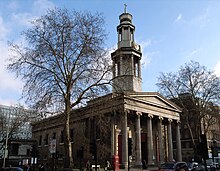St Pancras New Church
| St Pancras Church | |
|---|---|

St Pancras Church, 2007
|
|
| Country | United Kingdom |
| Denomination | Church of England |
| Churchmanship | Liberal Anglo-Catholic |
| Website | www |
| Architecture | |
| Heritage designation | Grade I listed |
| Designated | 10 June 1954 |
| Architect(s) | William and Henry William Inwood |
| Style | Neoclassical, Greek Revival |
| Administration | |
| Diocese | London |
| Clergy | |
| Vicar(s) | Anne Stevens |
St Pancras Church is a Greek Revival church in St Pancras, London, built in 1819–22 to the designs of William and Henry William Inwood. It was historically often referred to as St Pancras New Church, in order to distinguish it from St Pancras Old Church, which stands some way to the north.
The church is on the northern boundary of Bloomsbury, on the south side of Euston Road, at the corner of Upper Woburn Place, in the borough of Camden. When it was built its west front faced into the south-east corner of Euston Square, which had been laid out on either side of what was then simply known as the "New Road". It was intended as a new principal church for the parish of St Pancras, which once stretched almost from Oxford Street to Highgate. The original parish church was small ancient building to the north of New Road. This had become neglected following a shift in population to the north, and by the early 19th century services were only held there once a month, worship at other times taking place in a chapel in Kentish Town. With the northwards expansion of London into the area, the population in southern part of the parish grew once more, and a new church was felt necessary. Following the opening of the New Church, the Old Church became a chapel of ease, although it was later given its own separate parish. During the 19th century many further churches were built to serve the burgeoning population of the original parish of St Pancras, and by 1890 it had been divided into 33 ecclesiastical parishes.
The New Church was built primarily to serve the newly built up areas close to Euston Road, especially parts of the well-to-do district of Bloomsbury. The building of St Pancras church was agreed in 1816. After a competition involving thirty or so tenders, designs by the local architect William Inwood, in collaboration with his son Henry William Inwood, were accepted. The builder was Isaac Seabrook. The first stone was laid by the Duke of York at a ceremony on 1 July 1819. It was carved with a Greek inscription, of which the English translation was "May the light of the blessed Gospel thus ever illuminate the dark temples of the Heathen".
...
Wikipedia
